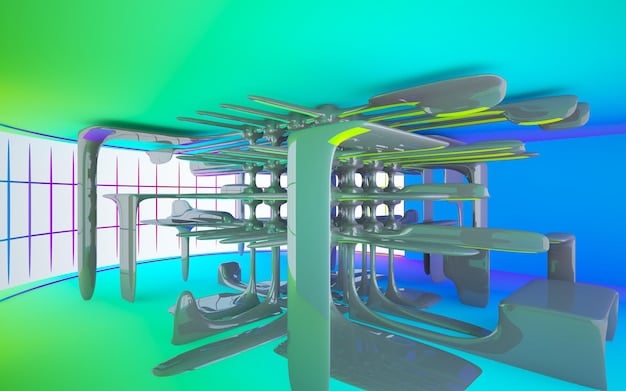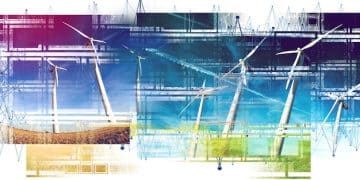Carbon Capture: US Net-Zero by 2050? Unpacking the Technology

Advertisements
Achieving net-zero emissions by 2050 in the US critically depends on carbon capture technology as a complementary solution to decarbonization efforts, addressing hard-to-abate sectors and legacy emissions.
Advertisements
The ambitious goal of achieving net-zero emissions by 2050 in the United States requires a multifaceted approach, and at the forefront of this complex discussion is carbon capture technology: can it really help the US achieve net-zero emissions by 2050? This technology, once a niche concept, is now central to climate conversations, promising to mitigate the impact of continued fossil fuel use and address emissions from hard-to-decarbonize industries.
Understanding Carbon Capture: The Basics
Carbon capture, utilization, and storage (CCUS) is a suite of technologies designed to prevent large amounts of carbon dioxide (CO2) from entering the atmosphere. This process involves capturing CO2 from industrial sources, such as power plants and factories, or directly from the ambient air, before either reusing it or storing it permanently underground.
Advertisements
The fundamental principle behind carbon capture is to intercept CO2 before it becomes a potent greenhouse gas. This can occur at various stages of an industrial process or even after the CO2 has been released into the atmosphere, albeit at much lower concentrations. The technologies involved are complex, yet their potential impact on global climate objectives is immense.
Pre-Combustion Capture
Pre-combustion capture focuses on removing CO2 before the fuel is burned. This method typically involves converting fossil fuels into a synthesis gas (syngas) composed of hydrogen and carbon monoxide. The carbon monoxide then reacts with steam to produce more hydrogen and CO2, with the CO2 easily separated and captured before combustion.
- Integrated Gasification Combined Cycle (IGCC) power plants are well-suited for this method.
- The high concentration of CO2 in the syngas makes separation more efficient.
- Hydrogen can then be used as a clean fuel for power generation.
This approach offers a cleaner energy pathway, particularly for coal-fired power plants, though its implementation requires significant retrofits or new infrastructure. The separation process happens under high pressure, which can aid in the efficiency of the capture.
Post-Combustion Capture
Post-combustion capture is perhaps the most widely recognized form of carbon capture. It involves separating CO2 from the flue gases after fossil fuels have been burned. These gases contain a mix of components, with CO2 typically making up a smaller percentage.
- Chemical absorption using solvents like amines is the most common technique.
- The CO2 binds to the solvent, which is then heated to release pure CO2 for capture.
- This method can be retrofitted to existing power plants and industrial facilities.
Despite its flexibility, post-combustion capture faces challenges related to energy intensity, as heating the solvent requires substantial energy, leading to a parasitic load on power plants. However, ongoing research aims to develop new, more efficient solvents and processes.
In essence, carbon capture technologies come in various forms, each with its own set of advantages and challenges. Their deployment often depends on the specific industrial process, the concentration of CO2, and the economic viability of the project. A comprehensive understanding of these basics is crucial for evaluating their role in the broader climate mitigation landscape.
The Role of Carbon Capture in US Decarbonization
The US government has identified carbon capture as a critical component in its strategy to achieve net-zero emissions by 2050. This isn’t merely a theoretical consideration; it’s a pragmatic recognition that certain sectors are inherently difficult to decarbonize through electrification or renewable energy alone.
Heavy industries such as cement, steel, and chemicals produce significant process emissions that are not tied to fuel combustion, making traditional decarbonization methods less straightforward. Here, carbon capture offers a viable pathway to reduce their carbon footprint. Moreover, it can play a crucial role in managing emissions from existing industrial infrastructure that cannot be immediately replaced or retired.
Addressing Hard-to-Abate Sectors
For sectors like cement and steel production, CO2 is an inherent byproduct of chemical reactions, not just energy use. For instance, in cement manufacturing, heating limestone releases CO2 directly. In steel production, carbon is a necessary component in the reduction of iron ore.
- Cement and steel account for a substantial portion of global industrial emissions.
- Renewable energy alone cannot eliminate these process emissions.
- Carbon capture offers a direct solution for these specific industrial processes.
Without carbon capture, achieving deep decarbonization in these sectors is extremely challenging, if not impossible, within the set timeframe. It provides a bridge technology, allowing these fundamental industries to continue operating while moving towards a decarbonized future.
Complementing Renewable Energy Expansion
While renewable energy sources like solar and wind are expanding rapidly, they are intermittent and cannot entirely replace dispatchable power generation overnight. Natural gas power plants, for example, often serve as a flexible backup to renewables, and fitting them with carbon capture can significantly lower their emissions profile.
- Ensures grid stability by allowing cleaner fossil fuel power.
- Reduces reliance on a single pathway for decarbonization.
- Supports energy security during the clean energy transition.
This complementary role means that carbon capture is not an alternative to renewables but rather an essential tool that ensures reliability and manages the complexity of transitioning away from a fossil-fuel-dependent energy system. It enables a more diversified approach to emissions reduction, spreading the risk and accelerating progress.
Therefore, the integration of carbon capture into the US decarbonization strategy is not a sign of wavering commitment to renewables, but rather a realistic acknowledgment of the economic and technical challenges involved in a full-scale energy transition. It represents a pragmatic layer of defense against climate change, addressing emissions that other solutions cannot easily mitigate.
Current State of Carbon Capture Projects in the US
The landscape of carbon capture projects in the US is dynamic, with various initiatives in different stages of development. While some large-scale projects have been operational for years, many new ones are emerging, driven by policy incentives and growing industry interest in reducing emissions.
Existing projects often focus on enhanced oil recovery (EOR), where captured CO2 is injected into oil reservoirs to increase oil extraction. While commercially viable, this practice has drawn criticism for potentially prolonging fossil fuel extraction. However, newer projects are increasingly focused on dedicated geological storage, aiming for permanent sequestration.
Operational Projects and Pipelines
Several carbon capture facilities are currently operational across the US, primarily concentrated in regions with significant industrial activity and suitable geological formations for storage. These include plants in Texas, Wyoming, and Illinois, capturing CO2 from power generation, ethanol production, and natural gas processing.
- The Petra Nova project in Texas for power plant emissions.
- Carbon capture at ethanol facilities like Summit Carbon Solutions.
- Existing CO2 pipelines facilitate transportation to storage sites.
These projects demonstrate the technical feasibility of carbon capture at scale, providing valuable operational experience and contributing to the development of best practices. The existing pipeline infrastructure for CO2, though limited, offers a starting point for expanding transportation networks.
Proposed Projects and Future Growth
The pipeline of proposed carbon capture projects is robust, reflecting increased investment and policy support. Many new projects are targeting critical industrial sectors, aiming to capture millions of tons of CO2 annually. These proposals span diverse industries, from cement and steel to chemicals and hydrogen production.

- Growing interest in direct air capture (DAC) projects, though still nascent.
- Government incentives like the 45Q tax credit driving new investments.
- Development of regional carbon capture hubs to streamline infrastructure.
The future growth of carbon capture is heavily reliant on federal and state policies that de-risk investment and accelerate deployment. The concept of “hubs” where multiple industrial sources can share capture and transport infrastructure is gaining traction as a cost-effective strategy. This collaborative approach can significantly reduce the per-ton cost of carbon capture.
While the current scale of carbon capture in the US is modest compared to the total emissions, the trajectory suggests a significant increase in deployment over the coming decades. The success of these projects will depend on overcoming technical, economic, and social challenges to ensure widespread adoption and meaningful emissions reductions.
Challenges and Limitations of Carbon Capture
Despite its promise, carbon capture technology faces significant challenges that hinder its widespread adoption and raise questions about its ultimate effectiveness in achieving net-zero emissions. These limitations range from economic viability to environmental concerns and public perception.
The high capital costs associated with building and retrofitting carbon capture facilities remain a major barrier. Energy penalties, where a portion of the power generated is consumed by the capture process itself, further reduce efficiency and increase operational expenses. These economic factors make it difficult for carbon capture to compete with alternative decarbonization strategies without substantial subsidies or carbon pricing mechanisms.
High Costs and Energy Penalties
Implementing carbon capture systems requires substantial upfront investment for equipment, installation, and infrastructure. For existing plants, retrofitting can be complex and expensive due to space constraints and integration challenges. These costs often make carbon capture projects financially unattractive compared to other emission reduction options.
- Capital expenditures for capture equipment are a significant hurdle.
- Operational costs, including energy for solvent regeneration, are high.
- Lack of a strong carbon price signal limits economic incentive.
The “energy penalty” refers to the energy consumed by the carbon capture process, which can reduce the net output of a power plant by 10-30%. This not only increases the operational cost but also means that more fuel must be burned to produce the same amount of net energy, potentially leading to more upstream emissions.
Storage Safety and Public Acceptance
The long-term storage of captured CO2 underground, in saline aquifers or depleted oil and gas reservoirs, raises concerns about safety and permanence. While geological storage has been studied extensively and deemed safe by many experts, public apprehension regarding potential leaks, seismic activity, or contamination remains a challenge.
- Ensuring the long-term integrity of storage sites is crucial.
- Monitoring technologies are needed to detect potential leaks.
- Overcoming public skepticism and NIMBYism (Not In My Backyard) is vital.
Effective public engagement and transparent communication are essential to address these concerns and build trust in carbon storage solutions. Without social license, even technically viable projects can face significant delays or outright opposition, as seen with some past initiatives.
In addition to these, carbon capture is often seen as a “band-aid” solution by some environmental groups, arguing that it distracts from the fundamental need to transition away from fossil fuels entirely. This perception, coupled with the inherent technical and economic hurdles, underscores that carbon capture is not a silver bullet, but rather one tool among many in the fight against climate change.
Policy and Investment Landscape
The US policy landscape has increasingly recognized the strategic importance of carbon capture, leading to a surge in both legislative and private investment initiatives. Federal and state governments are implementing various incentives and funding mechanisms to accelerate the deployment of CCUS technologies, aiming to overcome the economic barriers and spur innovation.
Key among these policies are tax credits and direct funding for research, development, and demonstration projects. These measures are designed to reduce the financial risk for companies investing in carbon capture, making it a more attractive option for industrial emitters and energy producers.
Federal Incentives: 45Q Tax Credit and BIL
The 45Q tax credit has been a cornerstone of federal support for carbon capture, providing tax credits for each ton of CO2 captured and stored or utilized. Recent amendments within the Inflation Reduction Act have significantly enhanced the value of this credit, making carbon capture projects more economically viable.
- Increased credit values for direct air capture and industrial capture.
- Lowered capture thresholds to include smaller projects.
- Extended timelines for project commencement.
Beyond 45Q, the Bipartisan Infrastructure Law (BIL) has allocated billions of dollars towards carbon capture and storage initiatives, including funding for carbon dioxide transport infrastructure, storage hubs, and DAC pilot projects. These investments signal a strong commitment from the federal government to scale up CCUS technologies across the nation.
Private Sector Engagement and Investment
Spurred by policy incentives and growing environmental, social, and governance (ESG) pressures, private sector investment in carbon capture has seen a marked increase. Energy companies, industrial players, and tech startups are exploring and investing in CCUS projects, from large-scale industrial retrofits to innovative direct air capture solutions.

- Major oil and gas companies diversifying into CCUS.
- Venture capital flowing into direct air capture startups.
- Consortia forming to develop regional carbon capture hubs.
This increased private sector engagement is crucial, as it brings not only capital but also engineering expertise and operational experience to the table. Strategic partnerships between industrial emitters and specialized carbon capture technology providers are becoming more common, paving the way for integrated, large-scale projects.
The combination of robust federal policy support and a committed private sector suggests a promising outlook for carbon capture deployment in the US. However, continued collaboration and sustained investment will be necessary to overcome remaining hurdles and realize the full potential of these technologies in the race to net-zero.
The Future Outlook: Can CCS Close the Gap by 2050?
Assessing whether carbon capture and storage (CCS) can truly help the US achieve net-zero emissions by 2050 requires a forward-looking perspective that considers both the accelerating pace of technological development and the ambitious scale of the climate challenge. While CCS is not a panacea, it is increasingly viewed as an indispensable tool in the broader decarbonization toolkit.
Many projections from reputable energy agencies and climate models, including those from the International Energy Agency (IEA) and the Intergovernmental Panel on Climate Change (IPCC), indicate that achieving net-zero without significant deployment of CCS would be considerably more difficult and costly. This is particularly true for hard-to-abate sectors and for providing negative emissions when combined with bioenergy (BECCS) or direct air capture (DAC).
Technological Advancements and Scalability
Ongoing research and development are continually improving the efficiency and reducing the cost of carbon capture technologies. Innovations in new solvents, membrane technologies, and adsorbent materials promise to lower the energy penalty and capital costs associated with capture. Direct air capture, while currently expensive, is also seeing significant investment and progress, potentially offering a solution for legacy emissions and diffuse sources.
- New capture materials like metal-organic frameworks (MOFs).
- Modular and standardized designs reducing construction times.
- Advancements in energy-efficient CO2 compression and pipelines.
The scalability of CCS projects also depends on the availability of sufficient geological storage capacity. Preliminary assessments suggest that the US has vast storage potential, far exceeding projected needs. The challenge lies in characterizing these sites, obtaining permits, and developing the necessary infrastructure for transport and injection at scale.
Integration with Other Climate Solutions
It’s crucial to reiterate that CCS is not a standalone solution but a complementary one. Its effectiveness in achieving net-zero emissions by 2050 relies heavily on its integration with other decarbonization strategies, notably the rapid deployment of renewable energy, energy efficiency improvements, and the electrification of transportation and heat.
- CCS can provide firm, low-carbon power to back up intermittent renewables.
- Supports the production of low-carbon hydrogen for industrial processes.
- Helps manage the transition for a fossil-fuel-dependent economy.
In this integrated vision, CCS acts as a crucial safety net and enabler for difficult-to-treat emissions, allowing for a more flexible and resilient transition. The role of CCS will likely evolve as other technologies mature, but its ability to target specific, high-emission sources and provide negative emissions makes it uniquely valuable for reaching ambitious climate targets.
Ultimately, the ability of CCS to close the gap by 2050 will depend on a combination of continued technological innovation, sustained policy support, and effective public engagement. While challenges remain, the current trajectory suggests that carbon capture will indeed be a vital part of the US strategy for achieving net-zero emissions, contributing significantly to a more sustainable future.
| Key Aspect | Brief Description |
|---|---|
| 🔬 Technology Types | Includes pre-combustion, post-combustion, and direct air capture. |
| 🏭 Decarbonization Role | Crucial for hard-to-abate sectors and complementing renewables. |
| 💰 Challenges | High costs, energy penalties, and public acceptance issues. |
| 📊 Outlook | Essential tool for US net-zero, reliant on innovation and policy. |
Frequently Asked Questions About Carbon Capture
▼
Direct air capture (DAC) is a technology that literally sucks carbon dioxide directly from the ambient air, rather than from a concentrated source like a power plant’s flue gas. Once captured, the CO2 can be permanently stored underground or used in various industrial processes. While highly versatile, DAC is currently more energy-intensive and expensive than capturing CO2 from point sources due to the lower concentration of CO2 in the atmosphere.
▼
Carbon capture contributes to net-zero emissions by either reducing emissions from ongoing industrial activities or by actively removing existing CO2 from the atmosphere. For industries where achieving zero emissions is technologically or economically prohibitive, carbon capture provides a pathway to lower their carbon footprint. When coupled with bioenergy or direct air capture, it can also create “negative emissions,” helping to offset residual emissions from hard-to-abate sectors.
▼
The “cleanliness” of carbon capture is debated. While it prevents CO2 from entering the atmosphere, the process itself requires energy, often fossil fuels, leading to its own emissions. Energy penalties vary by technology, but ongoing research aims to reduce this. Furthermore, if captured CO2 is used for enhanced oil recovery, it raises questions about the overall climate benefit. Proponents argue it’s a necessary bridge technology, while critics emphasize the need for direct emissions reductions.
▼
The primary risks of CO2 geological storage include potential leakage, which could release captured CO2 back into the atmosphere or contaminate groundwater, though this risk is generally considered low with proper site selection and monitoring. There’s also a theoretical, albeit minimal, risk of induced seismicity from pressure changes underground. Extensive research and operational experience indicate that large-scale, long-term storage can be conducted safely with robust monitoring and mitigation strategies.
▼
The cost of deploying carbon capture at a scale sufficient to meet net-zero goals is substantial, ranging from hundreds of billions to trillions of dollars over several decades. This includes capital costs for equipment, operational expenses, and infrastructure for transport and storage. However, these costs must be weighed against the economic damages and societal disruptions from unchecked climate change, which are projected to be far greater. Policy incentives like the 45Q tax credit aim to lower the financial burden.
Conclusion
The journey toward achieving net-zero emissions by 2050 in the United States is undeniably complex, fraught with technological, economic, and social challenges. Within this intricate landscape, carbon capture technology emerges not as a singular solution, but as a crucial and increasingly indispensable component of a comprehensive decarbonization strategy. While its deployment faces hurdles, particularly concerning cost, energy consumption, and public acceptance, ongoing innovation and robust policy support, such as the enhanced 45Q tax credit, are actively working to mitigate these barriers. Carbon capture’s unique ability to address emissions from hard-to-abate industrial sectors and its potential to provide negative emissions capabilities make it a vital complement to the widespread adoption of renewable energy. As the US accelerates its climate action, the strategic integration of carbon capture technologies will be pivotal in bridging the emissions gap and securing a sustainable, low-carbon future, proving to be a necessary tool rather than an optional luxury in this critical global endeavor.





